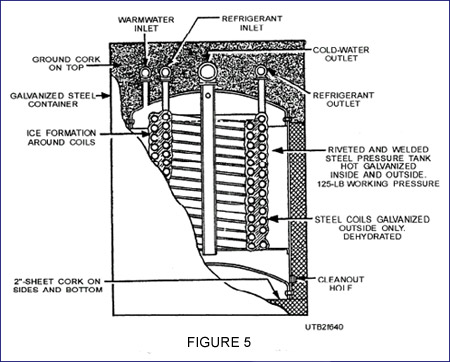Survey of Refrigeration Equipment
| Refrigeration equipment can be classified as either self-contained or
remote units. Self-contained equipment houses both the insulated
storage compartments (refrigerated), in which the evaporator is
located, and an uninsulated compartment (nonrefrigerated), in
which the condensing unit is located, in the same cabinet. This
type of equipment can be designed with a hermetically sealed,
semisealed, or an open condensing unit. These units are completely
assembled and charged at the factory and come ready for use with
little or no installation work. Self-contained refrigerating equipment
includes such equipment as domestic refrigerators and freezers,
water coolers, reach-in and walk-in refrigerators, small cold-storage
plants, and ice plants.
Remote refrigerating equipment has the condensing unit installed
in a remote location from the main unit. These types of units
are used where the heat liberated from the condenser cannot
enter the space where the unit is installed or space is limited
for installation. |
Reach-In Refrigerators
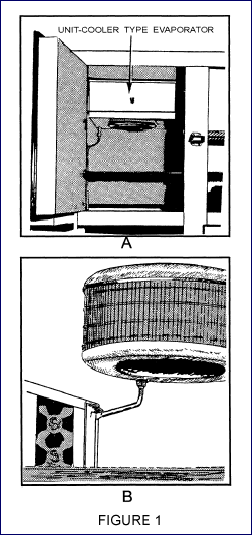 Reach-in refrigerators have a storage capacity of 15 cubic feet
or greater. They are mainly used for storing perishable foods,
but they can be found in medical facilities for storing biologicals,
serums, and other medical supplies requiring temperatures between
30°F and 45°F. Standard-size units most frequently used
are those with storage capacities between 15 and 85 cubic feet. Reach-in refrigerators have a storage capacity of 15 cubic feet
or greater. They are mainly used for storing perishable foods,
but they can be found in medical facilities for storing biologicals,
serums, and other medical supplies requiring temperatures between
30°F and 45°F. Standard-size units most frequently used
are those with storage capacities between 15 and 85 cubic feet.
Exterior finishes for reach-in refrigerators are usually of stainless steel,
aluminum, or vinyl, while the interior finishes are usually
metal or plastic, and the refrigerator cabinet is insulated
with board or batten type polystyrene or urethane. Reach-in
refrigerators are normally self-contained, with an air-cooled
condenser, but in larger refrigerators, with remote condensers,
water-cooled condensers are sometimes used. The evaporator is
mounted in the center of the upper portion of the food compartment.
In operation, warm air is drawn by the fan into the upper part
of the unit cooler, where it passes over the evaporator coils,
is cooled, and then is discharged at the bottom of the cooler.
The air then passes up through the interior and around the contents
of the refrigerator. The cycle is completed when the air again
enters the evaporator.
The low-pressure control is set to operate the evaporator on
a self-defrosting cycle, and temperature is thus control led.
Another type of control system uses both temperature and low-pressure
control or defrost on each cycle. The evaporator fan is wired
for continuous operation within the cabinet.
Evaporators in reach-in refrigerators are generally the unit
cooler type with dry coils (Fig. 1). In smaller capacity refrigerators,
ice-making coils, similar to those used in domestic refrigerators,
are often used as well as straight gravity coils. R-12 and R-502
are normally used in these units.
Back to Top |
Walk-In Refrigerators
Walk-in refrigerators are normally larger than reach-in types
and are either built-in or prefabricated sectional walk-in units.
They are made in two types - one for bulk storage of fresh meats,
dairy products, vegetables, and fruits requiring a temperature
from 35°F to 38°F and the other for the storage of frozen
food at temperatures of 10°F or below. The 35°F to 38°F
refrigerators are built and shipped in sections and assembled
at the location they are installed. They can be taken apart, moved,
and reassembled in another area if needed. Standard-size coolers
can be from 24 square feet up to 120 square feet in floor area.
A walk-in refrigerator with reach-in doors is shown in figure
2.
The exterior and interiors of these units are normally galvanized
steel or aluminum. Vinyl, porcelain, and stainless steel are
also used. Most walk-in refrigerators use rigid polyurethane
board, batten, or foamed insulation between the inner and outer
walls. For storage temperatures between 35°F to 40°F,
3 to 4 inches of insulation is generally used. For low-temperature
applications, 5 inches or more of insulation is used. These
refrigerators are equipped with meat racks and hooks to store
meat carcasses.
Walk-in refrigerators also have a lighting system inside the
refrigerator compartment. Most systems have the compressor and
condenser outside the main structure and use either a wall-mounted
forced-air or gravity-type evaporator that is separated from
the main part of the cabinet interior by a vertical baffle.
The operation of the walk-in refrigerator is similar to that
of the reach-in units. The evaporator must have sufficient capacity
(Btu per hour) to handle the heat load from infiltration and
product load.
Back to Top |
Domestic Refrigerators
Most domestic refrigerators are of two types—either a single
door fresh food refrigerator or a two-door refrigerator-freezer
combination, with the freezer compartment on the top portion of
the cabinet, or a vertically split cabinet (side-by-side), with
the freezer compartment on the left side of the cabinet. They
are completely self-contained units and are easy to install. Most
refrigerators use R-22 refrigerant, normally maintaining temperatures
of 0°F in the freezer compartment and about 35°F to 45°F
in the refrigerator compartment. The technician must be able to
perform various duties in the maintenance and repair of domestic
refrigerators, water coolers, and ice machines. This section provides
information to aid you in handling some of the more common types
of troubles. But let us remind you that the information given
here is intended as a general guide and should, therefore, be
used with the manufacturer's detailed instructions.
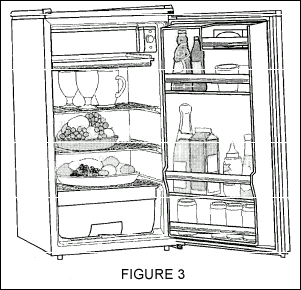 Single
Door Fresh Food Refrigerator Single
Door Fresh Food Refrigerator
A single door fresh food refrigerator (fig. 3) consists of
an evaporator placed either across the top or in one of the
upper corners of the cabinet. The condenser is on the back of
the cabinet or in the bottom of the cabinet below the hermetic
compressor. During operation, the cold air from the evaporator
flows by natural circulation through the refrigerated space.
The shelves inside the cabinet are constructed so air can circulate
freely past the ends and sides, eliminating the need for a fan.
This refrigerator has a manual defrost, which requires that
the refrigerator be turned off periodically (usually overnight)
to enable the buildup of frost on the evaporator to melt. Both
the outside and inside finish is usually baked-on enamel. Porcelain
enamel is found on steel cabinet liners. The interior of the
unit contains the shelves, lights, thermostats, and temperature
controls.
Two-Door Refrigerator-Freezer Combination
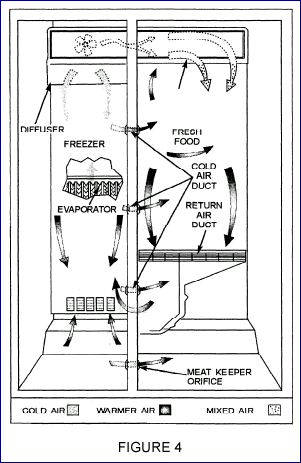 The
two-door refrigerator-freezer combination is the most popular
type of refrigerator. It is similar to the fresh food refrigerators
in construction and the location of components except it sometimes
has an evaporator for both the freezer compartment and the refrigerator
compartment. Also, if it is a frost-free unit, the evaporators
are on the outside of the cabinet. The
two-door refrigerator-freezer combination is the most popular
type of refrigerator. It is similar to the fresh food refrigerators
in construction and the location of components except it sometimes
has an evaporator for both the freezer compartment and the refrigerator
compartment. Also, if it is a frost-free unit, the evaporators
are on the outside of the cabinet.
Because of the two separate compartments (refrigerator-freezer)
and the larger capacity, these types of refrigerators use forced
air (fans) to circulate the air through the inside of both compartments.
The two-door refrigerator also has one of the following three
types of evaporator defrost systems: manual defrost, automatic
defrost, or frost-free.
There are two types of automatic defrosting: the hot gas system
or the electric heater system. The hot gas system, through the
use of solenoid valves, uses the heat in the vapor from the
compressor discharge line and the condenser to defrost the evaporator.
The other system uses electric heaters to melt the ice on the
evaporator surface.
A frost-free refrigerator-freezer (fig. 4) has the evaporator
located outside the refrigerated compartment. On the running
part of the cycle, air is drawn over the evaporator and is forced
into the freezer and refrigerator compartments by a fan. On
the off part of the cycle, the evaporators automatically defrost.
Refrigerator-freezer cabinets are made of pressed steel with
a vinyl or plastic lining on the interior wall surfaces and
a lacquer exterior finish. Most domestic refrigerators have
urethane foam or fiber glass insulation in the cabinet walls.
The side-by-side refrigerator-freezer arrangement has a number
of features not found in other refrigerators. In addition to
the automatic icemaker in the freezer compartment, it has an
option for a cold water dispenser, a cube or crushed ice dispenser,
and a liquid dispenser built into the door.
Back to Top |
Water Coolers and Ice
Machines
Water coolers provide water for drinking at a temperature under
50°F. Two types of water coolers are instantaneous and storage.
The instantaneous type only cools water when it is being drawn;
the storage type maintains a reservoir of cooled water. One instantaneous
method used places coils in a flooded evaporator through which
the water flows. A second instantaneous method uses double coils
with water flowing through the inner coil with refrigerant flowing
in the space between the inner coil and the outer coil. A third
instantaneous method is to coil the tubing in a water storage
tank. This allows refrigerant to flow through it (fig. 5).
Water coolers are of two basic designs—wall mounted or
floor mounted. Both types are the same in construction and operation;
the only difference is in the method of installation. Water
cooler cabinets have a sheet metal housing attached to a steel
framework. The condenser and hermetic compressor are located
in the housing base, and the evaporator is located in the cabinet
depending on its type of evaporator, but normally under the
drain basin. Most water coolers use a heat exchanger or precooler,
which precools the fresh water line to the evaporator, reducing
cooling requirements for the evaporator. A thermostat, which
is manually set and adjusted, is located in the cooler housing
close to the evaporator.
Ice machines are self-contained, automatic machines, ranging
from a small unit producing 50 pounds of ice per day to a commercial
unit producing 2,400 pounds of ice per day. The primary difference
in the design of these machines is the evaporator. They automatically
control water feed to the evaporator, freeze the water in an
ice cube mold, heat the mold and empty the ice into a storage
bin, and shut down when the storage bin is full.
Floats and solenoids control water flow, and switches operate
the storing action when ice is made. Electrical heating elements,
hot water, hot gas defrosting, or mechanical devices remove
the ice from the freezing surfaces depending on the unit. In
recent years, many companies have begun to manufacture their
units to use HFC R-404a refrigerant instead of HCFC R-22.
Back to Top |
|

 Reach-in refrigerators have a storage capacity of 15 cubic feet
or greater. They are mainly used for storing perishable foods,
but they can be found in medical facilities for storing biologicals,
serums, and other medical supplies requiring temperatures between
30°F and 45°F. Standard-size units most frequently used
are those with storage capacities between 15 and 85 cubic feet.
Reach-in refrigerators have a storage capacity of 15 cubic feet
or greater. They are mainly used for storing perishable foods,
but they can be found in medical facilities for storing biologicals,
serums, and other medical supplies requiring temperatures between
30°F and 45°F. Standard-size units most frequently used
are those with storage capacities between 15 and 85 cubic feet.
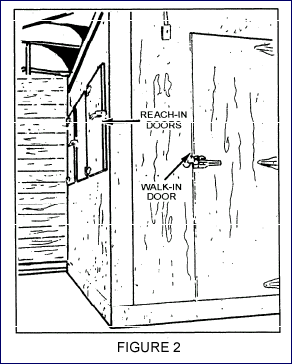
 Single
Door Fresh Food Refrigerator
Single
Door Fresh Food Refrigerator
 The
two-door refrigerator-freezer combination is the most popular
type of refrigerator. It is similar to the fresh food refrigerators
in construction and the location of components except it sometimes
has an evaporator for both the freezer compartment and the refrigerator
compartment. Also, if it is a frost-free unit, the evaporators
are on the outside of the cabinet.
The
two-door refrigerator-freezer combination is the most popular
type of refrigerator. It is similar to the fresh food refrigerators
in construction and the location of components except it sometimes
has an evaporator for both the freezer compartment and the refrigerator
compartment. Also, if it is a frost-free unit, the evaporators
are on the outside of the cabinet.
